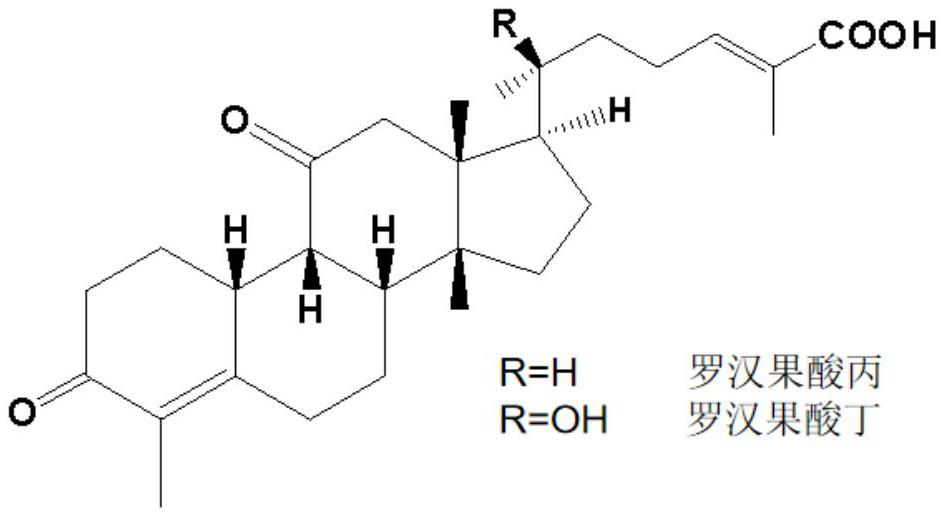A continuous method for separating multiple mogrosinic acid monomers from Luo Han Guo root
A technology of Luo Han Guo and a continuous method, which is applied in the field of separation of natural triterpene acid monomers, can solve the problems of undisclosed and continuous acquisition of multiple high-content mogrosan fruit acid monomers, and achieve coherent processes, increased yields, and high yields Effect
- Summary
- Abstract
- Description
- Claims
- Application Information
AI Technical Summary
Problems solved by technology
Method used
Image
Examples
Embodiment 1
[0054] (1) Enzymolysis: take 10kg of dried Momordica grosvenori roots, pulverize to a particle size of 2-3mm, add 10kg of hydrochloric acid aqueous solution (pH=5), 0.02kg of sodium borate and 0.1kg of β-glucosidase, stir well, room temperature enzyme solution for 24 hours;
[0055] (2) Alkaline alcohol percolation: put the enzymatically hydrolyzed raw materials into the percolator, percolate and extract with 80L of alkaline methanol (the volume percentage concentration of methanol is 70%, which contains 1% sodium hydroxide), and percolation The flow rate is 1.0BV / hour, and the percolating liquid is obtained;
[0056] (3) Ceramic membrane filtration: filter the leachate with a ceramic membrane with a pore size of 50nm (filtration pressure 0.4Mpa) to obtain a ceramic membrane filtrate;
[0057] (4) decolorization: the ceramic membrane filtrate is passed through the alumina chromatography column (the consumption of alumina is 3kg, the height-diameter ratio of the chromatography...
Embodiment 2
[0064] (1) Enzymolysis: take 10kg of dried Momordica grosvenori roots, pulverize to a particle size of 2-3mm, add 15kg of dilute hydrochloric acid aqueous solution (pH=6), 0.05kg of sodium borate and 0.2kg of β-glucosidase, stir well, room temperature Enzymatic hydrolysis for 18 hours;
[0065] (2) Alkaline alcohol percolation: put the enzymatically hydrolyzed raw materials into the percolator, percolate and extract with 100L of alkaline ethanol (the volume percentage concentration of ethanol is 80%, which contains 0.8% potassium hydroxide), and percolation The flow rate is 1.5BV / hour, and the permeate is obtained;
[0066] (3) Ceramic membrane filtration: filter the leachate with a ceramic membrane with a pore size of 50nm (filtration pressure 0.4Mpa) to obtain a ceramic membrane filtrate;
[0067] (4) decolorization: the ceramic membrane filtrate is passed through the alumina chromatographic column (the consumption of alumina is 2kg, the height-diameter ratio of the chromat...
Embodiment 3
[0074] (1) Enzymolysis: take 10kg of dried Momordica grosvenori roots, pulverize to a particle size of 2-3mm, add 15kg of dilute sulfuric acid aqueous solution (pH=5), 0.03kg of sodium borate and 0.15kg of β-glucosidase, stir well, room temperature Enzymatic hydrolysis for 20 hours;
[0075] (2) Alkaline alcohol percolation: put the enzymatically hydrolyzed raw materials into the percolator, percolate and extract with 90L of alkaline methanol (the volume percentage concentration of methanol is 85%, which contains 1.5% of sodium hydroxide), and percolation The flow rate is 0.8BV / hour, and the percolating liquid is obtained;
[0076] (3) Ceramic membrane filtration: filter the leachate with a ceramic membrane with a pore size of 100 nm (filtration pressure 0.2 Mpa) to obtain a ceramic membrane filtrate;
[0077] (4) decolorization: the ceramic membrane filtrate is passed through the magnesia chromatography column (the consumption of magnesia is 2.6kg, the height-diameter ratio ...
PUM
| Property | Measurement | Unit |
|---|---|---|
| pore size | aaaaa | aaaaa |
| particle diameter | aaaaa | aaaaa |
| particle diameter | aaaaa | aaaaa |
Abstract
Description
Claims
Application Information
 Login to View More
Login to View More - Generate Ideas
- Intellectual Property
- Life Sciences
- Materials
- Tech Scout
- Unparalleled Data Quality
- Higher Quality Content
- 60% Fewer Hallucinations
Browse by: Latest US Patents, China's latest patents, Technical Efficacy Thesaurus, Application Domain, Technology Topic, Popular Technical Reports.
© 2025 PatSnap. All rights reserved.Legal|Privacy policy|Modern Slavery Act Transparency Statement|Sitemap|About US| Contact US: help@patsnap.com


